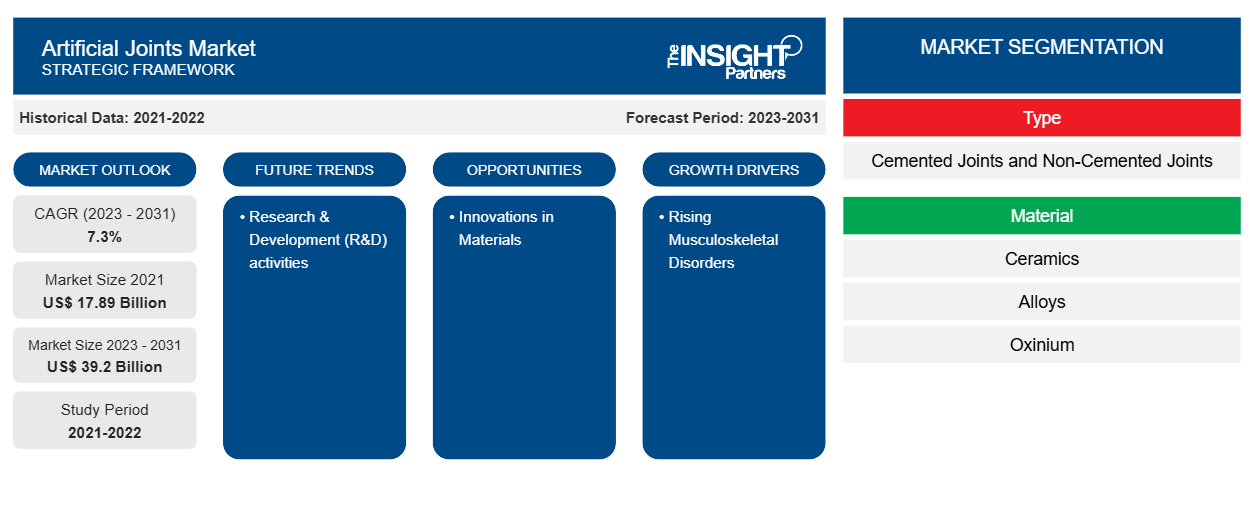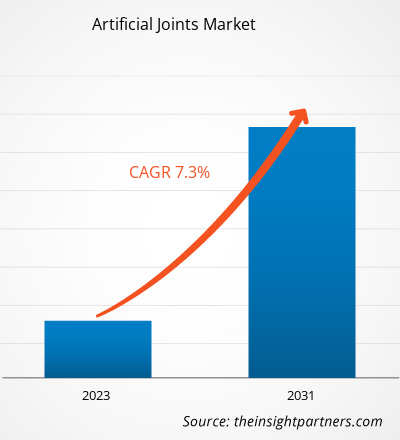The Artificial JointsMarket was valued at US$ 17.89 billion in 2021 and is expected to reach US$ 39.2 billion by 2031. The market is expected to register a CAGR of 7.3% from 2023–2031. Research & Development (R&D) activities is likely to remain key Artificial Joints Market trends.
Artificial JointsMarket Analysis
Rising Musculoskeletal Disorders
Joint replacements have become an intrinsic factor for maintenance and restoration to treat a wide range of musculoskeletal problems among musculoskeletal disorders. For instance, in 2019, in England, more than 200,000 hip and knee replacements were performed, with 189 hip replacements and 130 knee replacements. Therefore, with rising musculoskeletal disorders, there is an accelerated demand for artificial joints. Modern artificial joints are high-tech products made from specialized materials using unique technological equipment. These designs are justified and designed based on system analysis methods, the physiological state of the patients, and the elimination of the complications. Therefore, the development of modern artificial joints with non-invasive surgery option, less painful for the patients are the most influential factors responsible for artificial joints market growth during 2021-2031.
Artificial JointsMarket Overview
Technology, innovation, and smart technological solutions such as continue to influence Artificial Joints significantly. Rising musculoskeletal disorders and smart technologies in artificial jointsare the most influential factors responsible for Artificial Joints Market growth. Research & Development (R&D) activities is a key trend for Artificial Joints Market growth. Innovations in materials will provide lucrative market opportunity.
Customize This Report To Suit Your Requirement
You will get customization on any report - free of charge - including parts of this report, or country-level analysis, Excel Data pack, as well as avail great offers and discounts for start-ups & universities
Artificial Joints Market: Strategic Insights

-
Get Top Key Market Trends of this report.This FREE sample will include data analysis, ranging from market trends to estimates and forecasts.
Artificial JointsMarket Drivers and Opportunities
Smart Technologies in Artificial Joints to Favor Market
Manufacturers want to design smart orthopaedic implants that monitor progression in patients. Webster is one such manufacturer that is in the process of development of smart orthopaedic implants that monitor patients progression and then transmit the information to healthcare professionals through radio and a handheld device. If infection occurs, the implants could not only alert doctors, but also can release a drug. Traditionally, strong and lightweight titanium is a material choice for artificial implants. However, Webster is using a different material other than titanium with an oxidized surface that's coated with carbon nanotubes with working as an electrode. By applying a voltage and measuring the conductivity of the implant surface, doctors could use the nanotubes to sense one of the three things that can happen to an implant. Therefore, smart artificial joints will take a considerable market in the coming years and even top manufacturers like Zimmer Biomet will develop devices that will overcome traditional artificial joints implants methods.
Innovations in Materials for Artificial Joints Market– An Opportunity
With innovation in surgical techniques, procedures like hip replacements and knee operations have become a common practice. Additionally, innovation in artificial joint materials will provide lucrative market opportunities for the manufacturers in the long run. For example, the development of a patented type of nylon can be used as an extra coating on top of the plastic surface of a replacement joint. This surface covers the ball part of a ball-and-socket joint, usually composed of an "ultra-high-molecular-weight polyethylene (UHMWPE)" material. Additionally, experiments are still being done using nylon coating to merge with the UHMWPE to create a new material with exciting characteristics. Therefore, material innovation in artificial joints will provide lucrative market opportunities accounting for considerable market share in the coming years.
Artificial Joints
Market Report Segmentation Analysis
Key segments that contributed to the derivation of the Artificial Joints Market analysis are candidature and services.
- Based on Type, the Artificial Joints Market is bifurcated into cemented joints and non-cemented joints. The cemented joints may hold a larger market share in 2023.
- Based on Material, the Artificial Joints Market is segmented into ceramics, alloys, oxinium, and others. The ceramics may hold a larger market share in 2023.
- Based on Application, the Artificial Joints Market is segmented into artificial joints of knee, artificial joints of hip, artificial joints of shoulder, and others. The artificial joints of knee may hold a larger market share in 2023.
- Based on End User, the Artificial Joints Market is segmented into Hospitals, Ambulatory Care Centers, and Others. The Hospitals may hold a larger market share in 2023.
Artificial Joints Market Share Analysis by Geography
The geographic scope of the Artificial JointsMarket report is mainly divided into five regions: North America, Asia Pacific, Europe, Middle East & Africa, and South America/South & Central America.
North America has dominated the Artificial Joints Market. In North America, US accounts considerable share for artificial joints. Presence of top medical manufacturers present in the US and rising R&D activities in terms of materials are the most influential factors responsible for market growth. Asia Pacific is anticipated to grow with the highest CAGR in the coming years.
Artificial Joints
Artificial Joints Market Regional InsightsThe regional trends and factors influencing the Artificial Joints Market throughout the forecast period have been thoroughly explained by the analysts at The Insight Partners. This section also discusses Artificial Joints Market segments and geography across North America, Europe, Asia Pacific, Middle East and Africa, and South and Central America.
Artificial Joints Market Report Scope
| Report Attribute | Details |
|---|---|
| Market size in 2021 | US$ 17.89 Billion |
| Market Size by 2031 | US$ 39.2 Billion |
| Global CAGR (2023 - 2031) | 7.3% |
| Historical Data | 2021-2022 |
| Forecast period | 2023-2031 |
| Segments Covered |
By Type
|
| Regions and Countries Covered |
North America
|
| Market leaders and key company profiles |
|
Artificial Joints Market Players Density: Understanding Its Impact on Business Dynamics
The Artificial Joints Market is growing rapidly, driven by increasing end-user demand due to factors such as evolving consumer preferences, technological advancements, and greater awareness of the product's benefits. As demand rises, businesses are expanding their offerings, innovating to meet consumer needs, and capitalizing on emerging trends, which further fuels market growth.

- Get the Artificial Joints Market top key players overview
Artificial JointsMarket News and Recent Developments
The Artificial JointsMarket is evaluated by gathering qualitative and quantitative data post primary and secondary research, which includes important corporate publications, association data, and databases. The following is a list of developments in the market for Artificial Joints and strategies:
- In February 2020, RSIP Vision announced introducing a computer-based vision technology to more accurately visualize bone before knee and hip replacement procedures to reduce human error.
Artificial JointsMarket Report Coverage and Deliverables
The “Artificial JointsMarket Size and Forecast (2021–2031)” report provides a detailed analysis of the market covering below areas:
- Market size and forecast at global, regional, and country levels for all the key market segments covered under the scope
- Market dynamics such as drivers, restraints, and key opportunities
- Key future trends
- Detailed PEST/Porter’s Five Forces and SWOT analysis
- Global and regional market analysis covering key market trends, major players, regulations, and recent market developments
- Industry landscape and competition analysis covering market concentration, heat map analysis, prominent players, and recent developments
- Detailed company profiles
- Historical Analysis (2 Years), Base Year, Forecast (7 Years) with CAGR
- PEST and SWOT Analysis
- Market Size Value / Volume - Global, Regional, Country
- Industry and Competitive Landscape
- Excel Dataset
Recent Reports
Testimonials
Reason to Buy
- Informed Decision-Making
- Understanding Market Dynamics
- Competitive Analysis
- Identifying Emerging Markets
- Customer Insights
- Market Forecasts
- Risk Mitigation
- Boosting Operational Efficiency
- Strategic Planning
- Investment Justification
- Tracking Industry Innovations
- Aligning with Regulatory Trends





















 Get Free Sample For
Get Free Sample For